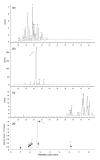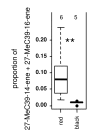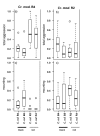Tropical parabiotic ants: Highly unusual cuticular substances and low interspecific discrimination - PubMed (original) (raw)
Tropical parabiotic ants: Highly unusual cuticular substances and low interspecific discrimination
Florian Menzel et al. Front Zool. 2008.
Abstract
Background: Associations between animal species require that at least one of the species recognizes its partner. Parabioses are associations of two ant species which co-inhabit the same nest. Ants usually possess an elaborate nestmate recognition system, which is based on cuticular hydrocarbons and allows them to distinguish nestmates from non-nestmates through quantitative or qualitative differences in the hydrocarbon composition. Hence, living in a parabiotic association probably necessitates changes of the nestmate recognition system in both species, since heterospecific ants have to be accepted as nestmates.
Results: In the present study we report highly unusual cuticular profiles in the parabiotic species Crematogaster modiglianii and Camponotus rufifemur from the tropical rainforest of Borneo. The cuticle of both species is covered by a set of steroids, which are highly unusual surface compounds. They also occur in the Dufour gland of Crematogaster modiglianii in high quantities. The composition of these steroids differed between colonies but was highly similar among the two species of a parabiotic nest. In contrast, hydrocarbon composition of Cr. modiglianii and Ca. rufifemur differed strongly and only overlapped in three regularly occurring and three trace compounds. The hydrocarbon profile of Camponotus rufifemur consisted almost exclusively of methyl-branched alkenes of unusually high chain lengths (up to C49). This species occurred in two sympatric, chemically distinct varieties with almost no hydrocarbons in common. Cr. modiglianii discriminated between these two varieties. It only tolerated workers of the Ca. rufifemur variety it was associated with, but attacked the respective others. However, Cr. modiglianii did not distinguish its own Ca. rufifemur partner from allocolonial Ca. rufifemur workers of the same variety.
Conclusion: We conclude that there is a mutual substance transfer between Cr. modiglianii and Ca. rufifemur. Ca. rufifemur actively or passively acquires cuticular steroids from its Cr. modiglianii partner, while the latter acquires at least two cuticular hydrocarbons from Ca. rufifemur. The cuticular substances of both species are highly unusual regarding both substance classes and chain lengths, which may cause the apparent inability of Cr. modiglianii to discriminate Ca. rufifemur nestmates from allocolonial Ca. rufifemur workers of the same chemical variety.
Figures
Figure 1
Gas chromatograms of cuticular hydrocarbons of the parabiotic ant species. (a) Crematogaster modiglianii B2, (b) red Camponotus rufifemur R2, (c) black Camponotus rufifemur B4. Graphs were acquired with a GC-FID. Only substances beyond a chain length of 34 are shown since shorter hydrocarbons make up less than 2% of the profile. Numbers refer to table 1. *unknown, irregularly occurring substance. (d) Typical chromatogram of the cuticular steroids of Cr. modiglianii, acquired with GC-MS. Arrows indicate the steroid compounds common to both Cr. modiglianii and Ca. rufifemur. Asterisks indicate the three steroids with highly similar mass spectra used for the second Mantel test. No other steroids were present in the colony shown.
Figure 2
Relative abundance of 27-MeC39-14-ene and 27-MeC39-16-ene in Cr. modiglianii workers living with the red vs. Cr. modiglianii workers living with the black Ca. rufifemur variety. Median, quartiles, range, and outliers (i.e. all data points deviating from the box by more than 1.5 times the interquartile range) are shown in the present and the following figures. The number of analyzed colonies is given above each plot. ** highly significant (p = 0.0043) according to U test.
Figure 3
Total aggression of Crematogaster modiglianii (colony R0) against different Camponotus colonies and species. Data are given as proportions in relation to the total number of interactions. Each plot represents 10 replicates.
Figure 4
Total aggression (a, b) and mounting behaviour (c, d) of Cr. modiglianii towards dead Ca. rufifemur from different colonies in arena assays. Data are given as proportions in relation to the total number of interactions. Each plot represents 10–13 replicates. (a), (c) Cr. Modiglianii B4, (b), (d) Cr. modiglianii R2.
Figure 5
Total aggression in allocolonial confrontations between parabiotic partners assays, pooled for variety combinations. Data are from [2], given as proportions in relation to the total number of interactions. The numbers above each plot indicate the overall number of replicates and the number of colony combinations tested. P values are given according to GLMs with binomial error distribution. (a) Cr. modiglianii towards Ca. rufifemur, (b) Ca. rufifemur towards Cr. modiglianii.
Similar articles
- Influence of Mutualistic Lifestyle, Mutualistic Partner, and Climate on Cuticular Hydrocarbon Profiles in Parabiotic Ants.
Sprenger PP, Hartke J, Feldmeyer B, Orivel J, Schmitt T, Menzel F. Sprenger PP, et al. J Chem Ecol. 2019 Sep;45(9):741-754. doi: 10.1007/s10886-019-01099-9. Epub 2019 Aug 27. J Chem Ecol. 2019. PMID: 31456059 - Crematoenones - a novel substance class exhibited by ants functions as appeasement signal.
Menzel F, Blüthgen N, Tolasch T, Conrad J, Beifuß U, Beuerle T, Schmitt T. Menzel F, et al. Front Zool. 2013 Jun 6;10(1):32. doi: 10.1186/1742-9994-10-32. Front Zool. 2013. PMID: 23742696 Free PMC article. - Parabiotic associations between tropical ants: equal partnership or parasitic exploitation?
Menzel F, Blüthgen N. Menzel F, et al. J Anim Ecol. 2010 Jan;79(1):71-81. doi: 10.1111/j.1365-2656.2009.01628.x. Epub 2009 Nov 5. J Anim Ecol. 2010. PMID: 19891712 - Recognition in a social symbiosis: chemical phenotypes and nestmate recognition behaviors of neotropical parabiotic ants.
Emery VJ, Tsutsui ND. Emery VJ, et al. PLoS One. 2013;8(2):e56492. doi: 10.1371/journal.pone.0056492. Epub 2013 Feb 22. PLoS One. 2013. PMID: 23451053 Free PMC article. - A review of ant cuticular hydrocarbons.
Martin S, Drijfhout F. Martin S, et al. J Chem Ecol. 2009 Oct;35(10):1151-61. doi: 10.1007/s10886-009-9695-4. Epub 2009 Oct 29. J Chem Ecol. 2009. PMID: 19866237 Review.
Cited by
- Candidate genes involved in cuticular hydrocarbon differentiation between cryptic, parabiotic ant species.
Sprenger PP, Hartke J, Schmitt T, Menzel F, Feldmeyer B. Sprenger PP, et al. G3 (Bethesda). 2021 May 7;11(5):jkab078. doi: 10.1093/g3journal/jkab078. G3 (Bethesda). 2021. PMID: 33729492 Free PMC article. - Influence of Mutualistic Lifestyle, Mutualistic Partner, and Climate on Cuticular Hydrocarbon Profiles in Parabiotic Ants.
Sprenger PP, Hartke J, Feldmeyer B, Orivel J, Schmitt T, Menzel F. Sprenger PP, et al. J Chem Ecol. 2019 Sep;45(9):741-754. doi: 10.1007/s10886-019-01099-9. Epub 2019 Aug 27. J Chem Ecol. 2019. PMID: 31456059 - The role of cuticular hydrocarbons in male mating behavior of the mustard leaf beetle, Phaedon cochleariae (F.).
Geiselhardt S, Otte T, Hilker M. Geiselhardt S, et al. J Chem Ecol. 2009 Oct;35(10):1162-71. doi: 10.1007/s10886-009-9704-7. Epub 2009 Oct 20. J Chem Ecol. 2009. PMID: 19838865 - How do cuticular hydrocarbons evolve? Physiological constraints and climatic and biotic selection pressures act on a complex functional trait.
Menzel F, Blaimer BB, Schmitt T. Menzel F, et al. Proc Biol Sci. 2017 Mar 15;284(1850):20161727. doi: 10.1098/rspb.2016.1727. Proc Biol Sci. 2017. PMID: 28298343 Free PMC article. - Crematoenones - a novel substance class exhibited by ants functions as appeasement signal.
Menzel F, Blüthgen N, Tolasch T, Conrad J, Beifuß U, Beuerle T, Schmitt T. Menzel F, et al. Front Zool. 2013 Jun 6;10(1):32. doi: 10.1186/1742-9994-10-32. Front Zool. 2013. PMID: 23742696 Free PMC article.
References
- Menzel F, Linsenmair KE, Blüthgen N. Selective interspecific tolerance in tropical Crematogaster-Camponotus associations. Animal Behaviour. 2008;75:837–846. doi: 10.1016/j.anbehav.2007.07.005. - DOI
- Orivel J, Errard C, Dejean A. Ant gardens: Interspecific recognition in parabiotic ant species. Behavioral Ecology and Sociobiology. 1997;40:87–93. doi: 10.1007/s002650050319. - DOI
- Hölldobler B, Wilson EO. The Ants. Berlin, Heidelberg: Springer Verlag; 1990.
- Vander Meer RK, Morel L. Nestmate Recognition in Ants. In: Vander Meer RK, Breed MD, Espelie KE, Winston ML, editor. Pheromone communication in social insects Ants, wasps, bees, and termites. Boulder: Westview Press; 1998. pp. 79–103.
LinkOut - more resources
Full Text Sources




